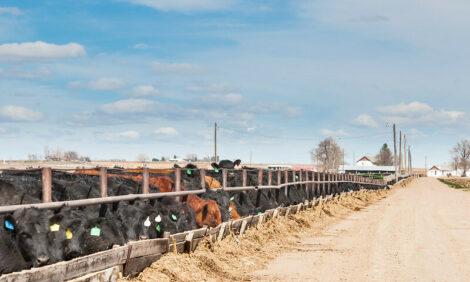



Reaching the Gold Standard
US - Precision matters to heart surgeons and air traffic controllers. In today’s market, it could be the key to profit for a cattle feeder and his customers.Tom Williams, owner and manager of Chappell Feedlot, knows all that. He employs technology and detailed sorting in his 7,500-head feedlot near the Nebraska town of the same name. The Certified Angus Beef LLC (CAB)-licensed partner is the first to achieve Gold Level – the highest – in the CAB Thirty-Aught-Six (30.06) program. Monthly recognition goes to harvest groups with at least 30% Certified Angus Beef (CAB) brand acceptance or grading USDA Prime. That’s provided there are no more than 3% Yield Grade (YG) 4 or 5, and 3% of carcasses weighing more than 1,000 pounds (lb.).
The Gold standing signifies more than 2,000 head of 30.06-designated cattle, cumulative since licensing.
“It’s a difficult mark to reach,” says Paul Dykstra, beef cattle specialist for CAB. “One that requires significant management and focused planning to create groups of cattle that almost entirely hit the beef carcass targets.”
Williams, who operates the feedlot with a small crew including his wife Cindy and son Travis, manages cattle with beef product quality in mind.
“The genetics are out there in the hands of our customers; when we get the cattle here, we use ultrasound to maximize each animal’s potential,” Williams says. Around 70 days pre-harvest, consulting veterinarian Lynn Locatelli scans cattle for the sort into three or four harvest groups. A computer calculates harvest dates and marketing methods, subject to human judgment.
The end result is an overall 40% CAB acceptance rate on 67 shipments of 30.06 cattle from Chappell over the past five years.
“That really sets this feedlot apart from many of the others,” says Dykstra, noting 12% of all Chappell’s CAB-enrolled cattle have qualified for 30.06. “You can see a very defined purpose of getting all the carcass quality possible out of the cattle they feed for their clientele.” Chappell’s most important objective is to make its customers money.
“If they’re lean enough to make them bigger, we make them bigger. Even with $7 corn you still want to feed them to an optimum endpoint, because the conversion is good until then,” Williams explains. “When you scan and sort, you know precisely what’s under the hide. Our conversions are very competitive.”
Feeding efficiency combined with carcass quality add up for the ranchers and the feedyard. “Most of our customers come here because of our marketing. Over time, you get a reputation of earning premiums year after year for people,” Williams says. “We work with a lot of people. Some of them are there, and some are getting there. People stay with us because they want their data and they’ll keep improving.
“That’s the kind of customers we like,” he adds: “the progressive ones who use their data.”
It seems fitting that data-driven producers would choose a feedyard with such impressive stats.
TheCattleSite News Desk


